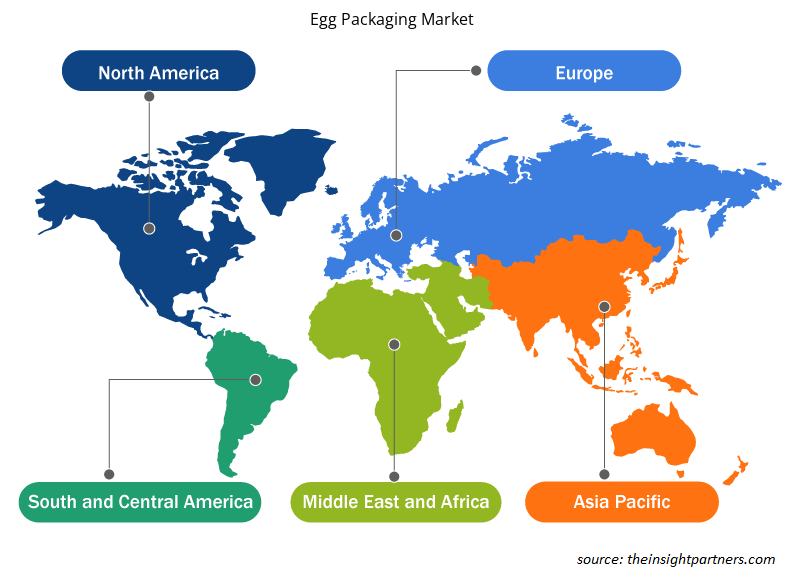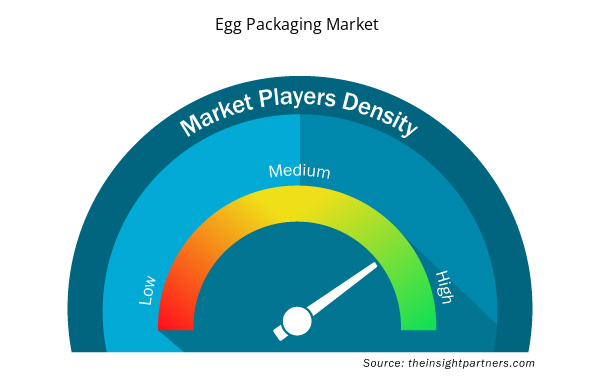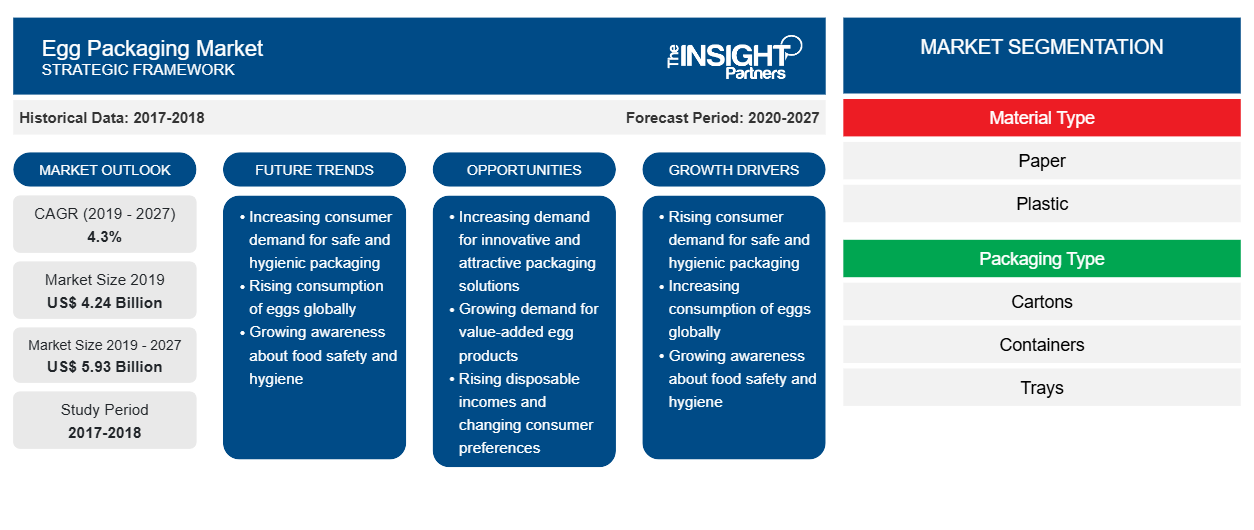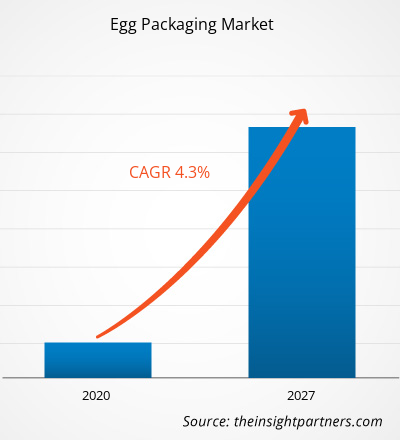2019 年鸡蛋包装市场价值为 42.4342 亿美元,预计到 2027 年将达到 59.3201 亿美元;预计 2020 年至 2027 年的复合年增长率为 4.3%。
鸡蛋包装是指专为鸡蛋的安全储存和运输而设计的包装材料。蛋壳脆弱多孔,需要坚固安全的包装解决方案。纸箱、托盘、篮子和容器是最常用的几种鸡蛋包装解决方案。它们由纸板、再生纸、聚对苯二甲酸乙二醇酯或聚苯乙烯制成。这些材料方便携带,还有助于吸收处理或运输鸡蛋时产生的压力或冲击。尽管如此,鸡蛋包装可以保护鸡蛋免受细菌、污染、天敌和水分流失的影响。所有这些好处都增加了对鸡蛋包装的需求。
2019 年,欧洲在鸡蛋包装市场占有重要份额。然而,预计亚太地区将成为预测期内增长最快的地区。欧洲鸡蛋包装市场的增长主要归因于鸡蛋消费量的增加以及餐饮和食品加工行业需求的增加。
2019 年 12 月,武汉首次报告了 COVID-19 疫情。截至 2021 年 2 月,美国、巴西、印度、俄罗斯、西班牙和英国是确诊病例和死亡人数最多的国家。由于封锁、旅行禁令和企业停业,疫情对各国的经济和行业产生了不利影响。食品和饮料是世界主要行业之一,遭受了供应链中断、技术活动取消和办公室关闭等严重破坏。例如,中国是全球制造业中心和各行业最大的原材料供应国,也是受影响最严重的国家之一。中国各工厂的封锁限制了全球供应链,扰乱了制造活动、交付计划和各种产品销售。多家公司已经宣布产品交付可能延迟,未来产品销售下滑。此外,欧洲、亚洲和北美国家实施的全球旅行禁令阻碍了商业合作和伙伴关系机会。所有这些因素都阻碍了食品和饮料行业的发展,从而成为该行业相关各个市场增长的制约因素。
定制此报告以满足您的需求
您可以免费定制任何报告,包括本报告的部分内容、国家级分析、Excel 数据包,以及为初创企业和大学提供优惠和折扣
- 获取此报告的关键市场趋势。这个免费样品将包括数据分析,从市场趋势到估计和预测。
市场洞察
越来越倾向于便捷地运输鸡蛋
鸡蛋包装是向消费者提供优质鸡蛋的重要部分。它可以保护鸡蛋免受细菌、污染、天敌和水分流失的影响。此外,鸡蛋包装还可以防止在处理、储存或运输过程中鸡蛋可能被压碎。与加工和配送过程中的任何其他步骤相比,运输过程中破损的鸡蛋数量更多。因此,破损鸡蛋造成的经济损失是因为出现裂缝会增加破损鸡蛋被细菌污染的风险,从而降低鸡蛋质量并导致食品安全问题。因此,托盘、纸板箱或纸箱形式的鸡蛋包装主要用于包装鸡蛋。纸箱可以为鸡蛋提供最出色的机械保护。纸箱具有凹陷形状,这种结构有助于保护鸡蛋免受储存和运输过程中施加的压力和冲击,从而抑制蛋壳可能被损坏或压碎。因此,制造商推出了多种形状和尺寸的鸡蛋盒,以方便鸡蛋的储存和运输。因此,人们对托盘、纸板箱或纸箱等形式的鸡蛋包装产品的兴趣日益浓厚,推动了鸡蛋包装市场的增长。
材料类型洞察
根据材料类型,鸡蛋包装市场分为纸张、塑料和其他材料。 2019 年,纸张包装占据了最高的市场份额。 纸质包装可以保护商品、减少浪费,而且可回收利用。 负责任地回收废纸和包装可以减少垃圾和填埋。 它可以防止因破损、变质和污染而造成的浪费,并延长产品的保质期。 纸质包装是一种多功能且经济高效的运输、保护和保存各种物品的方法。 它设计坚固而轻巧,可定制以满足产品或客户的特定需求。 纸质包装由纸浆制成。 从那时起,它的设计就没有太大变化。 它曾一度被 PET 包装取代,但公众更喜欢纸浆纸盒的自然外观和感觉。 纸质鸡蛋盒可生物降解,几乎所有当地回收机构都接受它。 所有这些因素都在推动纸质鸡蛋包装市场的增长。
一些主要的市场参与者是 Sonoco Products Company;Placon;Mauser Corporate GMBH;金富华包装工业有限公司 (JFH);Huhtamaki Oyj;CKF Inc.;Cascades Inc;Brodrene Hartmann AS;Reynolds Group Holdings Limited.;和 Cellulose de la Loire。鸡蛋包装市场的主要参与者专注于并购和产品发布等战略,以增加其全球地理影响力和消费者基础。 Sonoco Products Company; Placon; Mauser Corporate GMBH; JIN FU HUA PACKAGING INDUSTRIAL CO., LTD.(JFH); Huhtamaki Oyj; CKF Inc.; Cascades Inc; Brodrene Hartmann AS; Reynolds Group Holdings Limited.; and Cellulose de la Loire. Major players operating in the egg packaging market are focused on strategies such as mergers and acquisitions, and product launches to increase their geographical presence and consumer base globally.
鸡蛋包装市场区域洞察
Insight Partners 的分析师已详细解释了预测期内影响鸡蛋包装市场的区域趋势和因素。本节还讨论了北美、欧洲、亚太地区、中东和非洲以及南美和中美洲的鸡蛋包装市场细分和地理位置。

- 获取鸡蛋包装市场的区域特定数据
鸡蛋包装市场报告范围
| 报告属性 | 细节 |
|---|---|
| 2019 年市场规模 | 42.4 亿美元 |
| 2027 年市场规模 | 59.3亿美元 |
| 全球复合年增长率(2019 - 2027) | 4.3% |
| 史料 | 2017-2018 |
| 预测期 | 2020-2027 |
| 涵盖的领域 | 按材料类型
|
| 覆盖地区和国家 | 北美
|
| 市场领导者和主要公司简介 |
|
鸡蛋包装市场参与者密度:了解其对业务动态的影响
鸡蛋包装市场正在快速增长,这得益于终端用户需求的不断增长,而这些需求又源于消费者偏好的不断变化、技术进步以及对产品优势的认识不断提高等因素。随着需求的增加,企业正在扩大其产品范围,进行创新以满足消费者的需求,并利用新兴趋势,从而进一步推动市场增长。
市场参与者密度是指在特定市场或行业内运营的企业或公司的分布情况。它表明在给定市场空间中,相对于其规模或总市场价值,有多少竞争对手(市场参与者)存在。
在鸡蛋包装市场运营的主要公司有:
- Sonoco 产品公司
- 普拉康
- 毛瑟公司有限公司
- 金富华包装工业有限公司(JFH)
- 赫塔迈基公司
免责声明:上面列出的公司没有按照任何特定顺序排列。

- 了解鸡蛋包装市场主要参与者概况
报告亮点
- 全球鸡蛋包装市场的渐进式行业趋势可帮助参与者制定有效的长期战略
- 发达市场和发展中市场采用的业务增长战略
- 2017年至2027年全球鸡蛋包装市场定量分析
- 各行业对鸡蛋包装的需求估计
- PEST 分析可说明行业内买家和供应商预测市场增长的有效性
- 了解竞争激烈的市场形势和对鸡蛋包装的需求的最新发展
- 市场趋势和前景以及推动和抑制鸡蛋包装市场增长的因素
- 通过了解支撑全球鸡蛋包装市场增长商业利益的战略来进行决策
- 各市场节点的鸡蛋包装市场规模
- 全球鸡蛋包装市场的详细概述和细分以及行业动态
- 各地区鸡蛋包装市场规模及增长潜力巨大
鸡蛋包装市场,按材料类型
- 纸
- 纸板
- 再生纸
- 其他的
- 塑料
- 聚对苯二甲酸乙二醇酯
- 聚苯乙烯
- 其他的
- 其他的
鸡蛋包装市场,按包装类型
- 纸箱
- 容器
- 托盘
- 其他的
公司简介
- Sonoco 产品公司
- 普拉康
- 毛瑟公司有限公司
- 金富华包装工业有限公司(JFH)
- 赫塔迈基公司
- CKF 公司
- 卡斯卡德公司
- 布罗德内·哈特曼
- 雷诺集团控股有限公司。
- 卢瓦尔纤维素
- 历史分析(2 年)、基准年、预测(7 年)及复合年增长率
- PEST 和 SWOT 分析
- 市场规模价值/数量 - 全球、区域、国家
- 行业和竞争格局
- Excel 数据集



Report Coverage
Revenue forecast, Company Analysis, Industry landscape, Growth factors, and Trends

Segment Covered
This text is related
to segments covered.

Regional Scope
North America, Europe, Asia Pacific, Middle East & Africa, South & Central America

Country Scope
This text is related
to country scope.
常见问题
Paper-based packaging protects goods, reduces waste and is recyclable. Packaging reduces waste. Recycling waste paper and packaging responsibly reduces litter and landfill. It prevents waste through breakage, spoilage and contamination, and extends product shelf life. Paper-based packaging is a versatile and cost-efficient method to transport, protect and preserve a wide array of items. It is engineered to be sturdy, yet lightweight, and is customizable to meet product- or customer-specific needs. It is made from paper pulp Its design has not changed much since then. It was replaced for a while with PET packaging but the public preferred the natural look and feel of the paper pulp carton. Paper egg cartons are biodegradable and accepted by almost all local recycling agencies. This further propels the growth of the paper segment in the global egg packaging market.
The major players operating in the global egg packaging market are Sonoco Products Company., Placon, MAUSER Group, Jin Fu Hua Packaging Industrial Co.,Ltd, Huhtamaki Oyj, CKF Inc., Cascades Inc., Hartmann, Reynolds Group Holdings Limited, Cellulose de la Loire and among others.
In 2019, the egg packaging market was dominated by Rest of World region at the global level. Rest of the world comprises several developing regions such as Asia- Packaging, Middle- East and Africa, and South America. The high rate of poultry farming and increasing consumption of egg-based foods supports the demand for egg packaging in the rest of the world. Advancements in food processing industries leading to the launch of egg-based products also support market growth. Moreover, growing awareness about the health benefits along with high protein content favors the eggs, which is further propelling the demand of egg packaging in the rest of the world.
Trends and growth analysis reports related to Chemicals and Materials : READ MORE..
The List of Companies - Egg Packaging Market
- Sonoco Products Company
- Placon
- Mauser Corporate GMBH
- JIN FU HUA PACKAGING INDUSTRIAL CO.,LTD.(JFH)
- Huhtamaki Oyj
- CKF Inc.
- Cascades Inc
- Brodrene Hartmann AS
- Reynolds Group Holdings Limited.
- Cellulose de la Loire
The Insight Partners performs research in 4 major stages: Data Collection & Secondary Research, Primary Research, Data Analysis and Data Triangulation & Final Review.
- Data Collection and Secondary Research:
As a market research and consulting firm operating from a decade, we have published and advised several client across the globe. First step for any study will start with an assessment of currently available data and insights from existing reports. Further, historical and current market information is collected from Investor Presentations, Annual Reports, SEC Filings, etc., and other information related to company’s performance and market positioning are gathered from Paid Databases (Factiva, Hoovers, and Reuters) and various other publications available in public domain.
Several associations trade associates, technical forums, institutes, societies and organization are accessed to gain technical as well as market related insights through their publications such as research papers, blogs and press releases related to the studies are referred to get cues about the market. Further, white papers, journals, magazines, and other news articles published in last 3 years are scrutinized and analyzed to understand the current market trends.
- Primary Research:
The primarily interview analysis comprise of data obtained from industry participants interview and answers to survey questions gathered by in-house primary team.
For primary research, interviews are conducted with industry experts/CEOs/Marketing Managers/VPs/Subject Matter Experts from both demand and supply side to get a 360-degree view of the market. The primary team conducts several interviews based on the complexity of the markets to understand the various market trends and dynamics which makes research more credible and precise.
A typical research interview fulfils the following functions:
- Provides first-hand information on the market size, market trends, growth trends, competitive landscape, and outlook
- Validates and strengthens in-house secondary research findings
- Develops the analysis team’s expertise and market understanding
Primary research involves email interactions and telephone interviews for each market, category, segment, and sub-segment across geographies. The participants who typically take part in such a process include, but are not limited to:
- Industry participants: VPs, business development managers, market intelligence managers and national sales managers
- Outside experts: Valuation experts, research analysts and key opinion leaders specializing in the electronics and semiconductor industry.
Below is the breakup of our primary respondents by company, designation, and region:

Once we receive the confirmation from primary research sources or primary respondents, we finalize the base year market estimation and forecast the data as per the macroeconomic and microeconomic factors assessed during data collection.
- Data Analysis:
Once data is validated through both secondary as well as primary respondents, we finalize the market estimations by hypothesis formulation and factor analysis at regional and country level.
- Macro-Economic Factor Analysis:
We analyse macroeconomic indicators such the gross domestic product (GDP), increase in the demand for goods and services across industries, technological advancement, regional economic growth, governmental policies, the influence of COVID-19, PEST analysis, and other aspects. This analysis aids in setting benchmarks for various nations/regions and approximating market splits. Additionally, the general trend of the aforementioned components aid in determining the market's development possibilities.
- Country Level Data:
Various factors that are especially aligned to the country are taken into account to determine the market size for a certain area and country, including the presence of vendors, such as headquarters and offices, the country's GDP, demand patterns, and industry growth. To comprehend the market dynamics for the nation, a number of growth variables, inhibitors, application areas, and current market trends are researched. The aforementioned elements aid in determining the country's overall market's growth potential.
- Company Profile:
The “Table of Contents” is formulated by listing and analyzing more than 25 - 30 companies operating in the market ecosystem across geographies. However, we profile only 10 companies as a standard practice in our syndicate reports. These 10 companies comprise leading, emerging, and regional players. Nonetheless, our analysis is not restricted to the 10 listed companies, we also analyze other companies present in the market to develop a holistic view and understand the prevailing trends. The “Company Profiles” section in the report covers key facts, business description, products & services, financial information, SWOT analysis, and key developments. The financial information presented is extracted from the annual reports and official documents of the publicly listed companies. Upon collecting the information for the sections of respective companies, we verify them via various primary sources and then compile the data in respective company profiles. The company level information helps us in deriving the base number as well as in forecasting the market size.
- Developing Base Number:
Aggregation of sales statistics (2020-2022) and macro-economic factor, and other secondary and primary research insights are utilized to arrive at base number and related market shares for 2022. The data gaps are identified in this step and relevant market data is analyzed, collected from paid primary interviews or databases. On finalizing the base year market size, forecasts are developed on the basis of macro-economic, industry and market growth factors and company level analysis.
- Data Triangulation and Final Review:
The market findings and base year market size calculations are validated from supply as well as demand side. Demand side validations are based on macro-economic factor analysis and benchmarks for respective regions and countries. In case of supply side validations, revenues of major companies are estimated (in case not available) based on industry benchmark, approximate number of employees, product portfolio, and primary interviews revenues are gathered. Further revenue from target product/service segment is assessed to avoid overshooting of market statistics. In case of heavy deviations between supply and demand side values, all thes steps are repeated to achieve synchronization.
We follow an iterative model, wherein we share our research findings with Subject Matter Experts (SME’s) and Key Opinion Leaders (KOLs) until consensus view of the market is not formulated – this model negates any drastic deviation in the opinions of experts. Only validated and universally acceptable research findings are quoted in our reports.
We have important check points that we use to validate our research findings – which we call – data triangulation, where we validate the information, we generate from secondary sources with primary interviews and then we re-validate with our internal data bases and Subject matter experts. This comprehensive model enables us to deliver high quality, reliable data in shortest possible time.


 获取此报告的免费样本
获取此报告的免费样本